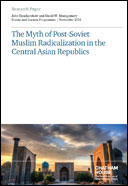Central Asia and Islamic Radicalization
Central Asia is generally considered to have a widespread and increasing problem with “Muslim radicalization” and yet there is little or no evidence of significant levels of Islamic extremism and political violence in the region. This erroneous framing of Islam, particularly political Islam, by security analysts of Central Asia distorts the issue in important ways. This paper identifies six widely-held misconceptions as part of a myth of post-Soviet Muslim radicalization in Central Asia. Using survey data and examples from fieldwork, it shows that “radicalization” of this kind is not borne out by the evidence. It argues that:
- There is all international security discourse of Post-Soviet Muslim radicalization in Central Asia. The accounts of many international security analysts, while explicitly critical of the repression of moderate Islam by Central Asian governments, assume that isolated incidences of violent extremism are part of a process of post-Soviet Muslim radicalization. As part of this myth, such violence is assumed to be related to non-violent forms of political Islam and societal trends towards greater public expression of piety.
- There is little evidence to support the idea of post-Soviet Muslim radicalization. In particular, the threat of violent extremism is both of a lower magnitude than that identified in the myth and different in form. It is isolated, localized and inhibited by secularization as much as it is driven by radicalization.
- The myth of radicalization is important as it is politically influential. It supplies a common but fallacious set of reference points. It is these reference points which may provide the basis for common threat perceptions, collaboration in counter-radicalization initiatives and international security assistance in the region. In that the myth acts as a legitimating device for the militant secularism of weak regimes, it may be a greater problem than violent extremism itself.

